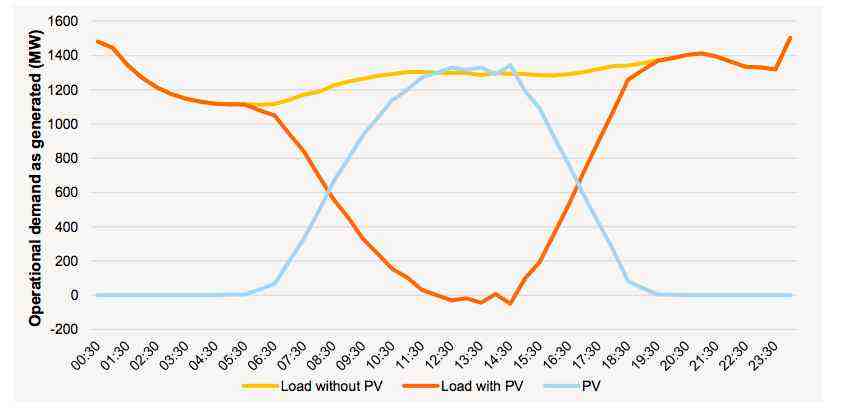See also Rooftop solar to overtake coal capacity before 2030
The Australian Energy Market Operator predicts that the growing uptake of rooftop solar by homes and businesses will reduce grid demand in South Australia on certain occasions to zero by 2023, highlighting the rapid change in the nature of energy markets, and the growing shift from centralised baseload generation.
The predictions from AEMO came in its 2015 National Electricity Forecasting Report, released on Thursday. It says that the near 575MW of rooftop solar is already accounting for one-third of total grid demand on certain days in the state.
But within a decade this total could treble, pushing minimum demand required from the grid in the whole state to below 0MW (zero) on some occasions in 2023-24, and for several hours at a time by 2024/25 – when AEMO expects 1864MW of rooftop solar.
It says zero demand from the grid could last from 11.30am to 2.30pm local time on some days.
“These observations from the 2015 NEFR reflect both the changing generation mix, and increasing consumer engagement when it comes to choice and energy supply solutions,” CEO Matt Zema notes.
But the impacts could be even more dramatic. The forecast is based on AEMO’s “medium scenario”. Given the propensity to underestimate the proliferation of solar deployment, it is worth mentioning AMEO’s high scenario, which suggests capacity of around 2,200MW of rooftop solar by 2024/25, and more than 3,000MW a decade later.
The high scenario suggests that rooftop solar will account for nearly one-quarter of the state’s total annual demand within a decade and nearly one-third of annual demand by 2034/35, when the rooftop solar market reaches “saturation”.
The state already sources one-third of its demand from wind generation, suggesting that on AEMO’s numbers the state will easily beat the state government’s 50 per cent renewable energy target by 2025, and that does not include the number of wind projects and large-scale solar projects that could be built over the next five years.
AEMO is investigating the implications of its solar scenario, and it’s impact on system security and reliability of having zero demand from the grid. The obvious answer lies in storage, both at household and grid level, to even out the output of solar and push more towards use when the sun does not shine.
For the first time it released a “minimum demand” analysis for South Australia, an extraordinary development considering that just a few years ago market operators were only concerned with “maximum demand” scenarios.
AEMO will also shortly release inaugural Emerging Technology Information Paper, which will look at the viability of battery storage solutions for Australian residential consumers over the next 20 years, and the uptake of other technologies such as electric vehicles.
South Australia will be a test case for Australia, and indeed the world, because of its high level of “variable renewables” such as wind and solar in its energy mix.
It already stands at more than 40 per cent and AEMO expects this to grow as the renewable energy target encourages more wind generation and households continue to take up solar. One in four homes in the state already have solar PV.
Renewable proponents suggest that the two coal plants should be replaced with solar thermal and storage facilities, which have the flexibility to provide power when needed, and to store it when it is not required.
The International Energy Agency this week said wind and solar would play a critical role in reducing emissions from energy systems and helping to meet climate targets. It said variable renewables would account for 30 per cent of generation in Europe by 2030 and 20 per cent in the US.
In South Australia, the minimum load has already shifted from the early morning to the middle of the day, and peak demand has been shunted from the late afternoon to early evening, around 6.30pm. This is expected to move to 7.30pm as more solar is put into the grid.
South Australia is considered to be one of the prime markets for battery storage in Australia, given the high penetration of rooftop solar, and the difference between grid prices and payments for solar exports. Large-scale storage, at grid level, is also being considered in a trial co-sponsored by the Australian Renewable Energy Agency and AGL Energy.
See this story for state by state breakdown of AEMO solar PV forecasts.












